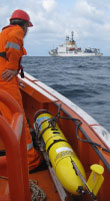"Gliders give us a new way to sample the ocean and sustain a presence offshore that we can afford." |
Dr. Glenn has pioneered the use of the underwater glider, an autonomous, mobile, long-duration sensor platform that
is an integral part of the COOL network.
The COOL Room uses the
Slocum glider developed by Teledyne Webb Research, and
they were the first to put a Slocum glider in the ocean, in 1999. Steady improvements in hardware and software have
focused on enhancing glider capabilities, culminating in the Atlantic Crossing, the first cross-Atlantic voyage by an
unmanned, underwater vehicle, a Slocum glider dubbed
The Scarlet Knight, in 2009.
"Gliders give us new ways to explore and observe the ocean," says Scott. "We get data we've never seen before, go
places we've never been before, go out in storms – it's a visionary tool." Gliders are part of what Scott calls the
"one-plus-one-equals-three scenario" – utilizing satellites in space, radar near the shore, and gliders beneath the
surface. Satellites and radar gather remote sensing data on water temperature and velocity, while gliders profile
through the water column, sampling in space and time, filling in the picture. "Our objective now is to figure out how to
have fleets of gliders flying underneath the remote sensing data to give us that one-plus-one-equals-three scenario,
that well-sampled ocean,” says Scott, “and then use that for scientific discovery, for societal applications, and for
education."
Gliders are also integral to Scott's work with the
Mid-Atlantic Regional Coastal Ocean Observing System
(MARCOOS). A fleet of gliders can cover the entire region and sustain a three-dimensional presence, which is particularly
important for MARCOOS' efforts in several areas: migratory fisheries management, ecosystem management, water quality,
shipping, coastal inundation, and energy extraction. Gliders also provide a conduit for listening to the climate change
signal. "Our mid-Atlantic coast is the interface between colder and tropical environments," says Scott. "A little change
moves that interface a lot. Gliders help us to better understand those changes so we can support people locally,
regionally, and globally."




